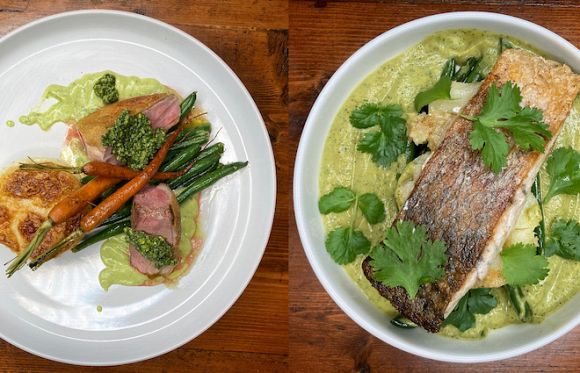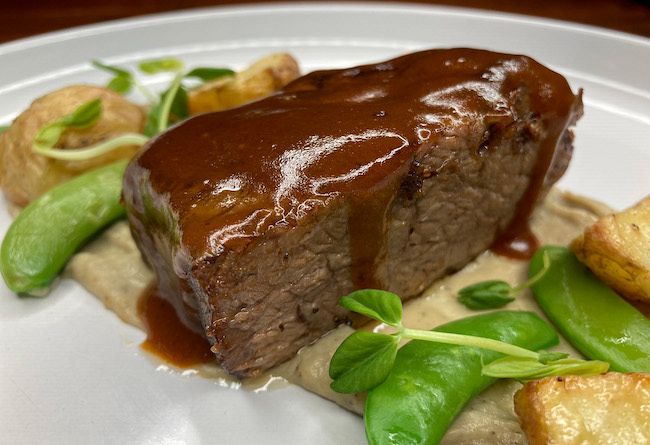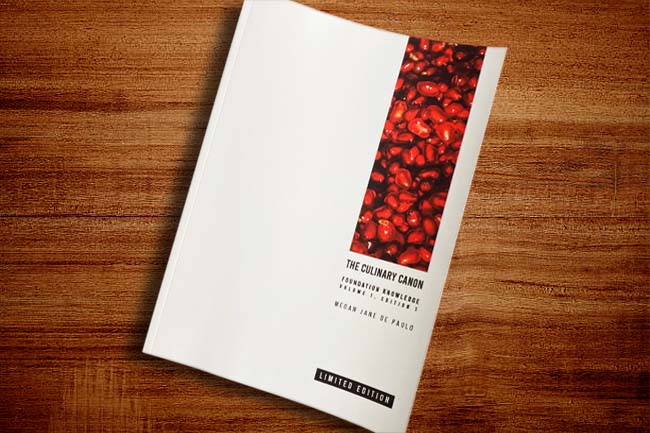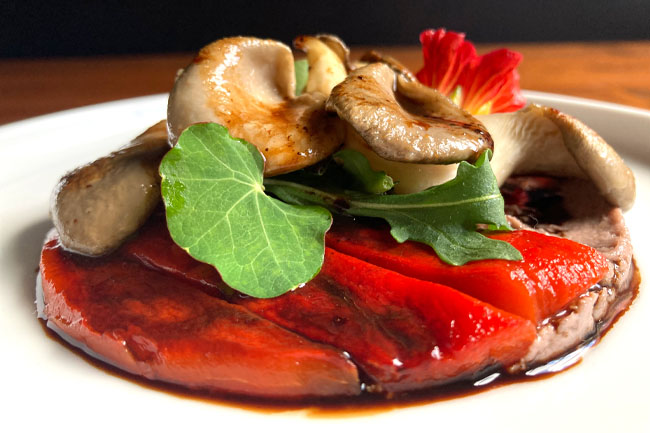This week Megan Jane de Paulo, creator of culinary delights and collector of recipes, lifts the lid on two of her most asked-for "how-tos" — gravy and poached eggs!
I’VE BEEN WORKING on something I hope will be just the first instalment of a range of volumes of recipes and techniques I’ve collected over a few decades of cooking: 'The Culinary Canon, Volume 1, Edition 1'. (This Ebook will be available online soon, with Kindle and print editions available shortly from Amazon.)
This first recipe collection focuses on some basic foundation cooking — with clear instructions and some science thrown in, and hopefully written in a style to pique your interest.
Two of the "how-tos" I’m most asked for are gravy and poached eggs!
Gravy
I didn’t think I’d manage to work in a "Nanna cooking story", but in true reality-TV cooking show/blogger fashion, I can when it comes to gravy.
"Instant gravy" didn’t exist in my world until I worked at a café that used it and I can still smell that chemical-to-me stench — and remember scraping the dried stuff off the bain marie pan.
I remember Nanna, on those special roast dinner days, flinging the roasting pan on top of the stove, adding flour and stirring like a whirling dervish, then adding hot water until the creative completion of the magical sauce we eagerly grabbed to drown our roasted carrots and limp cabbage. (Cabbage was boiled to a point no one could enjoy; carrots were roasted despite protestations of liking them raw.)
I was born in the era of having dinner dumped on your head if you didn’t eat it so that gravy was my saviour.
RECIPE
Gravy From Drippings
Remove the roasted meat and vegetables from the pan and set aside.
You can use the roasting pan to make the gravy if it’s a metal pan that can be used on a stovetop. However, you are probably more likely to scrape up the drippings and transfer to a heavier-bottomed saucepan with a smaller diameter to make it. Don’t strain out the crispy bits — that's where the flavour lives.
Gravy isn’t an exact science: it depends on how things come together.
- 40g pan drippings
- 30g all-purpose flour or cornstarch
- 1,000ml water or stock
Whisk the drippings and flour together over heat.
Gradually add in the water while whisking until the sauce thickens to gravy.
Add extra salt and pepper to taste.
Optional: Strain gravy for smoothness.
Gravy Without Drippings
You can build flavour with stock and spices, such as onion and gravy powder, to make a vegetarian gravy with meat drippings.
- 400ml beef stock
- 40g plain flour
- 40g butter
- 3g onion powder
- 3g garlic powder
- 20ml soy sauce
- salt
- pepper
Beef stock should be warm or at least room temperature — not directly from the fridge.
Add the butter and flour into a saucepan over heat to make a roux.
Once the roux is a paste, gradually add in stock while whisking to keep the gravy smooth.
Add in garlic and onion powder. Whisk.
Add in soy sauce.
Add salt and pepper to taste.
Option: Use chicken stock for a poultry dish.
Poached Eggs
For aficionados of the humble dual-toned nourishing ovoid, a perfectly poached egg – with a just quivering opaque smooth white enclosure concealing a liquid rush of rich yellow yolk – is the pinnacle of egg preparation perfection. And not all that difficult to achieve with some practice and taking some factors into consideration. There are multiple methods you can try.
RECIPE
Poached Egg Method 1 — The Naked Pot Simmer
This method only works with a super fresh egg.
Bring a pot of water to a simmering boil.
Crack an egg into a heatproof bowl.
Lower the egg gently into the vortex in the water. Poaching takes 3-4 minutes.
Remove with a slotted spoon or sieve.
Poached Egg Method 2 — The Whirlpool
Same instructions as above, but before you lower the egg in, swirl the water (clockwise or anti-clockwise is irrelevant).
The water action assists with keeping the whites in an ovoid shape while they firm up.
Poached Egg Method 3: Vinegar or Lemon Juice
This can be helpful if your eggs are still ok, but not super fresh.
Start with a pot of simmering water, add in 30mls of vinegar or lemon juice, which helps firm up the egg white while cooking.
Better to choose to apple cider or rice vinegar which have milder flavours.
Cook for 3-4 minutes, remove with slotted spoon. Can be gently rinsed under warm water to remove more of the vinegar scent.
Poached Egg Method 4 —This Is All Too Hard For Me
Place a saucepan of water on medium heat: you want a gentle boil.
Grab a generous length of plastic wrap and a tall glass.
Gently lay the plastic wrap over the glass and press down to create a pocket.
Crack an egg into the wrap.
Gather up the wrap and peg it closed, leaving enough space for the egg pocket to be submerged in the water. Lay two chopsticks across the top of the pan and lower the egg into the water, balancing the peg on the chopsticks.
Cook for 3-4 minutes and remove the wrap and egg.
(Yes, you can tie a knot. Ever tried to tie a knot in plastic wrap? It’s not great. Worse than tying a balloon. Also, untying is a pain and you can break the egg. But you do you!)
Poached Egg Method 5 — Frypan And Rings
This is handy for making around four poached eggs at once.
Place rings into pan and then add water to cover up to two-thirds of the ring depth.
Bring to a gentle simmer then crack eggs one at a time into a ring. Cover pan and poach for 3-4 minutes.
Poached Egg Method 6 — Piemaker
I like devices that have multiple uses. If you have one of these handy devices, you can use them to cook eggs. I’ve found this is a great way to teach kids to cook them (with supervision). Easier than using the stovetop and boiling water.
Put about 30ml of water in each pie cavity. Crack an egg in, lower the top and, in about 4 minutes, you have poached eggs!
Use a silicone spatula to remove so you don’t damage the surface.
Poached Egg Method 7 — Poaching Pan
Unless you are poaching six eggs at a time and can’t pay attention to them, I don’t see these pans as anything more than an opportunity to sell you another kitchen item.
SCIENCE:
According to the "all-things-egg" website 'get cracking':
'When poaching an egg, it is recommended you use fresh eggs because of the “yolk quality”. In a fresh egg, the yolk sits up high and the white is thick and closely surrounds the yolk. An older egg has a flat yolk that breaks easily and a thin, watery white.'
Vinegar is going to increase the rate of denaturing the egg protein and make that happen faster and help the poached egg hold its shape better.
Megan Jane de Paulo is a Melbourne-based, inner-city latte sipper and social media provocateur. You can follow Megan on Twitter @gomichild. Her new Ebook, 'The Culinary Canon, Volume 1, Edition 1', will be available soon HERE, with Kindle and print editions soon available HERE.
Related Articles
- Pumpkin tortillas: Using leftover food wisely
- Cooking with miso: Flavour for days
- How to adapt rich recipes for reuse and reinvention
- Hot cross buns early and all sorts a hot topic
- Mushroom season means magic meals
 This work is licensed under a Creative Commons Attribution-NonCommercial-NoDerivs 3.0 Australia License
This work is licensed under a Creative Commons Attribution-NonCommercial-NoDerivs 3.0 Australia License
Support independent journalism Subscribe to IA.













